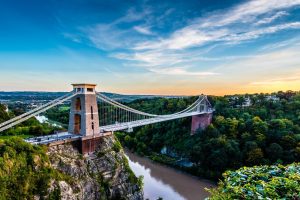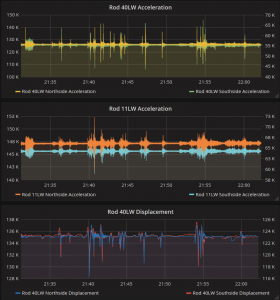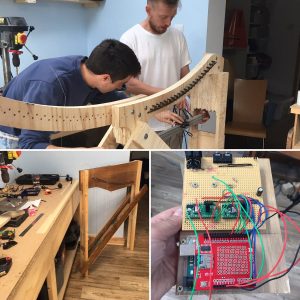Digital Bristol Week
A harp has been created inspired by the Clifton Suspension Bridge and transforms data from the bridge into sound. The harp was displayed as part of Digital Bristol Week on 20 October 2017 at a public event in the Hub on Bristol’s Waterfront. The event was popular, drawing in people who were walking past and could hear the relaxing sounds of the harp, as well as members of the University of Bristol and other organisations and businesses in Bristol. The event was reported on Radio 4’s Today programme, across the BBC radio network, including the World Service, Points West, Bristol 24/7 and TechSpark. Even a radio station in Honolulu was interested and has broadcast a piece! Read what the University of Bristol News said about the event – Harp at ee!
During the event people had the opportunity to hear about the project and how it came about from the engineers, musicians and luthier and were able to view the harp and listen to the robotic arms strumming the harp, which reflected the data from the suspension bridge. It was fascinating to see the data being transmitted live from the bridge and hearing the resulting sounds from the cleverly constructed instrument. Here is a little more about why the harp was built and the engineering project behind it……..
Monitoring the impact of people, traffic and weather on the Clifton Suspension Bridge

Background to the project
The UK’s bridges are vitally important for the movement of people and freight. However, many bridges are old and carry far more traffic than they were designed to. It’s therefore very important to monitor these structures and understand how they move; a change to the movement profile might indicate ageing or fatigue.
Monitoring the bridge
The University of Bristol set out to develop a low cost, easy to install bridge monitoring dashboard. The first trial of the software was run on the Clifton Suspension Bridge earlier in 2017. The system uses off the shelf wireless technology and big-data management techniques to collect information about how the bridge is moving. The data is then displayed to users – structural engineers or bridge management personnel – in real-time anywhere in the world. Six sensors monitored the bridge for a month, allowing the team to learn a lot about how the bridge moves and the effect vehicles, pedestrians and the weather have on the iconic structure. Whilst six sensors were needed to monitor the Clifton Suspension Bridge, the technology can scale to measure vibrations and displacements on far larger bridges
Using the data
The data is being used at the University of Bristol, by Civil Engineering to improve its structural models of the bridge and Engineering Mathematics to design a system to classify vehicle traffic. Now proven, there are plans to use the dashboard to monitor the Clifton Suspension Bridge for a second time as well as other bridges in the future.
Innovative infrastructure
Currently bridge inspections are predominantly visual, with an engineer periodically visiting the bridge to look for signs of fatigue. By combining mathematical models with real-time structural data it will be possible to identify problems more quickly, or possibly prevent them altogether. How a bridge moves also reflects what kind of traffic is moving across it, so fitting this system to motorway bridges, for example, will help traffic managers to understand how busy the road is at any given time.
The sensor system designed by the University of Bristol is low cost because it uses open-source software to manage, store and visualise data. The use of wireless technology means it can be installed quickly, easily and in more challenging locations. These factors combined mean we can now gain knowledge of structures that were previously deemed impossible.
How data from an iconic bridge is transformed into a musical installation: The Clifton Suspension Bridge Harp

Creating the installation
Bristol-based musicians and sound artists Yas Clarke and Lorenzo Prati worked with the University of Bristol’s Jean Golding Institute and the Music and Engineering departments to create an installation which musically represents structural data from Bristol’s iconic Clifton Suspension Bridge.
The harp
The harp was designed and built by Bristol-based Luthier and guitar maker, Sean Clark. It has 82 strings and is tuned in relation to the bridge’s natural frequency of 12.9Hz. The unique installation takes the form of a two-course harp resembling the Clifton Suspension Bridge. The instrument is played by two robotic arms, each strumming the strings on different sides of the harp. One represents data collected on the north side of the bridge, the other on the south side.
Driven by data
The monitoring sensors placed on the Clifton Suspension Bridge by the University earlier in 2017 produced data which is now being fed into a musical model that controls the arms of the harp. Six streams of data – four vibration and two displacement measurements – were analysed, combined and used to extrapolate information about the activity on the bridge. This data is then fed into the harp, driving the robotic arms to reflect the activity on the bridge. The more traffic, the busier and more dynamic the music. When the bridge is quiet, so is the instrument.

New ways of experiencing data
This project was developed by the Jean Golding Institute (JGI) at the University of Bristol, which supports interdisciplinary research in the area of data science. One area of interest to the JGI is to investigate the physical manifestations of information and explore innovative ways to represent data that creates an impactful response.
Acknowledgements
The monitoring system was created by Sam Gunner, Professor Eddie Wilson, Dr John Macdonald, Dr Paul Vardanega and Dr Theo Tryfonas from the Faculty of Engineering at the University of Bristol. The project was funded through an EPSRC Institutional Sponsorship. Thanks also to Clifton Suspension Bridge Trust – especially Bridge Manager, Trish Johnson – and Andrew Ramage at Techni Measure, local supplier of the wireless component of the system. Yas Clarke and Lorenzo Prati were the musicians and sound artists, Sean Clark (Luthier and guitar maker) contructed the harp and Sion Hannuna provided the Clifton Suspension bridge images.

